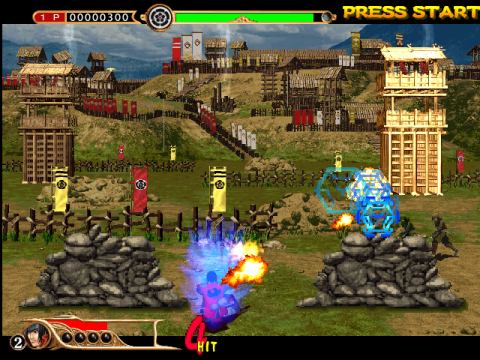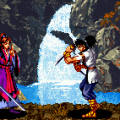This game is featured in our Arcade Cult Classics book, which is filled with other interesting and obscure arcade games!
Gamshara (“Daredevil”) meshes Sengoku-era Japan with futuristic technology, much like the shoot-em-ups MUSHA and Sengoku Blade. As the warriors Saika Magoichi and Hotaru, you take up arms against the mechanical army of Nobunaga Oda.
While there were a handful of Cabal-like gallery shooters released in the early-to-mid 90s, the genre petered out with the advent of 3D. However in 2002, Mitchell released Gamshara in arcades, making it seem like a relic out of time. While the company had been releasing a variety of arcade games throughout the 90s, by this point they had mostly transitioned into console puzzle games.
The game controls as expected, allowing you to move and aim a targeting cursor with the joystick, and hold down the fire button to stand in place. You can also jump to avoid enemy attacks, which is extremely handy because the bullet patterns are pretty dense. You can also activate Gamshara mode with the third button, which arms you with a super powerful rapid-fire cannon for a few seconds. Each character has a unique move, as Saika has a strong shot that’s fired off automatically after a rapid-fire volley, while Hotaru can double-jump. Killing enemies will drain the meter at the top of the screen; when this becomes empty, you either move into the next area or fight a boss battle.
Gamshara also uses a modernized scoring system. You’ll wrack up combos by gunning down enemies, but the counter resets if you jump or take damage. Jumping allows you to dodge almost anything, so it’s a risk/reward system that grants you higher points by keeping yourself in danger. Since every destroyed enemy increases your multiplier by one, you can get extremely high scores by playing as a daredevil.
The graphics are displayed at 640×480, making them higher resolution than the genre forebears. Some sections look decent while others are a little sterile. The problem with the higher detail is that it draws attention to the lack of animation in many scenes, making it seem like you’re playing on top of a painting. The legions of Nobunaga’s tanks look pretty cool, but the best fights are against the human foes. They’re microscopic targets, but they’ll jump or float around in the distance, tossing flying ships at you or summoning ninja duplicates. The entire final battle is against Nobunaga’s enormous castle, which is propped up on mechanical legs.


